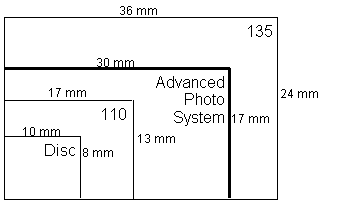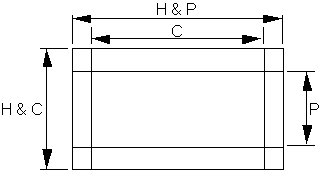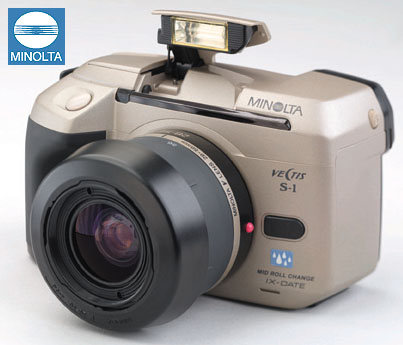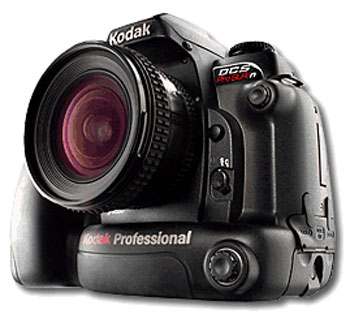The Digital Sensor: A Guide to Understanding Digital Cameras
by Wesley Fink on April 21, 2008 1:00 AM EST- Posted in
- Digital Camera
Why All these Different Sensor Sizes?
35mm first appeared on the scene in the 1930s and the film format simply took 35mm motion picture film and spooled it into a light-tight canister. By the 1960s, with point-and-shoot and developments in SLR technology, 35mm had become king of the film formats. Even as film manufacturers tried to introduce other film formats, 35mm continued to grow and prosper.
The SLR evolved in 35mm space and the world appeared orderly on the surface, but the only real constant was the size of the film. It was 35mm, but SLR manufacturers each championed their own lens mount and their exclusive lens line for their SLR film cameras. The primary advantage of the SLR was the ability to look through a wide variety of interchangeable lenses, and to accurately focus, meter, and later auto-focus through the viewing lens. As in today's digital SLR market, each manufacturer had their own lens mount, and lenses developed for one mount would not fit and work on others, i.e. a Nikon lens would not fit or work on a Canon camera.
APS (Advanced Photo System)
With the very early developments in digital photography, Kodak, Fuji, and others saw the handwriting on the wall for film photography. One of the ongoing complaints about 35mm film, however, has been that the 2:3 image format required image loss in almost every standard print size. Neither 8x10 nor 5x7 is a 2:3 ratio and both required cropping of the 35mm negative.

In 1996 a new APS (Advanced Photo System) initiative by Kodak, Fujifilm, Minolta, Nikon, Canon, and others was introduced to save film by standardizing on new ratios and adding new "computer-like" data storage capabilities in the taking and processing of film images. APS included a new film size - 30.2mm x 16.7mm - that could be printed full-frame (H or HDTV format), or use standard crops of 25.1mm x 16.7mm (C or Classic 2:3 format) or 9.5mm x 30.2mm (P or Panorama). Actually, the image size that was always shot was the 30.2mm x 16.7mm, and the other sizes were just standard crops.

The industry was confident they could sell APS, which in the most common C view was only about 55% of the already small 35mm size. Some manufacturers like Minolta developed new APS lens lines with smaller cameras and lenses, and Canon and Nikon developed APS camera bodies that could mount their regular lenses - and a few custom APS lenses.

In the end, APS failed in the film market. Industry pundits generally say APS failed because the negative was just too small, but it is more likely that it failed because it was just too late. Digital was on the near horizon, and many photographers did embrace smaller digital sensors while they rejected the smaller APS film format.
APS film is not that important in our discussion of digital photography, but the APS standard is important because it was also a standard for digital development. At the time of the APS initiatives, it seemed reasonable to aim for development of digital sensors for that same APS format, so lenses for both systems were interchangeable.
Most in the industry aimed for the APS C size sensor, which would be about 16.7mm x 25.1mm - the same ratio (2:3) as the classic 35mm format. Most manufacturers, burned by bad decisions in the APS film debacle, decided to keep their existing 35mm mounts, so their existing 35mm lenses could be used. They hedged their bets. This pleased current 35mm system owners, and camera makers could see if the new digital SLRs took hold. Once they were satisfied there was a market for digital SLR cameras, they could develop new lenses with a smaller image circle.

Canon and Nikon worked with Kodak in the early digital years to use their best film bodies with the current state-of-the-art Kodak sensors. These early DSLR cameras were incredibly expensive with massive power requirements and pro only. This development line culminated in the full-frame Kodak DCS Pro SLR/n and SLR/c. Those two cameras were the end of Kodak digital SLR cameras, although the company is still very active in the development and manufacture of digital imaging sensors and compact digital cameras.
Camera manufacturers introduced digital SLR products that revolved around the strength of their SLR business, the sensor capabilities they brought to manufacturing, and the relationships they had with other sensor manufacturers. Most of today's consumer DSLR cameras are based on sensors approximately APS C size, but they vary from the Olympus 4/3 sensor at 225mm² to the full-frame 35mm size with an area of 864mm².
Discussion of sensor size always tends to generate passionate discussion of the advantages of one manufacturer's sensor format over others, but please keep sensor sizes in perspective. The smallest 4/3 sensor still has 5.2x greater sensor area than the 43mm² sensor used in the 12MP Canon G9. The 4/3 sensor is 9x greater area than the common 1/2.5" compact sensor with an area of 25mm². Differences in digital SLR sensor size do matter, but they are very small compared to the difference in area between compact point and shoot digital sensors and today's digital SLR camera sensors.










72 Comments
View All Comments
andrewln - Monday, April 21, 2008 - link
This was followed in about 6 months by the introduction of the Samsung 14.6MP CMOS sensor in the Pentax D20.should be Pentax K20D
Wesley Fink - Monday, April 21, 2008 - link
Typo corrected. Unfortunately spell check can't catch model numbers that are misstated.araczynski - Monday, April 21, 2008 - link
now i know what pc tech illiterate people feel like :)its a good thing i don't care about photography, interesting read none the less.
finbarqs - Monday, April 21, 2008 - link
the thing is, I've read the reviews and saw the comparisons between the 5D and the D200 (I believe that was the last CCD sensor that Nikon used). The 5D has way better per-pixel sharpness than the D200. Perhaps the technology of the CMOS made it so it finally "looks" better than the CCD. Or at least on the Canon side of things. I'm not biased towards any camera. I've own an XTi, 5D, Panasonic DMC-L1, and now a D300. I'm hoping to own the next 5D MKII (or whatever they call it).Even the D2X used a CMOS sensor, and I thought Nikon made the D300 sensor, as well as the D3 sensor (FF). What I also find "funny" is that Sony doesn't have a FF sensor yet, but nikon does, thus leaving me to believe that Nikon came up with their own FF sensor.
melgross - Monday, April 21, 2008 - link
It's Nikon's own design, though I don't remember who makes it.haplo602 - Monday, April 21, 2008 - link
Nice article Wesley, finaly one Anandtech photo related article I enjoyed reading.On note on the growing megapixel count. Sooner more than later, DSLR in APS-C (and later full frame ones) will hit the same technology wall P&S are facing (too small photosite).
This is one factor that makes me a happy film shooter :-) I know that my limit is the scanner up to around 10MP and I have less flexibility in shooting conditions (either 2 bodies or limited by ISO and film type), in every other situation I am equal or better off.
I am waiting for an affordable Nikon full frame body and then I will make my switch to digital (but that is yet years to come).
wally626 - Monday, April 21, 2008 - link
A sensor technology improves APS-C will be able to go to high enough pixel counts and have very good quality. For most consumers some where around 12 MP is enough, if the sensors improve to where this can hit 3200 ISO with low noise 99 percent of the market would be satisfied.The full frame bodies will replace the medium formats of the film world. There have been some really good medium format cameras that take much better images than 35mm but very few are sold. I think the article is correct in saying the full-frame DSLR will be the PRO cameras and priced as such.
melgross - Monday, April 21, 2008 - link
The number ofpixels is directly related to the print size.If you go by the oft quoted 300 dpi on the final print for maximum quality, you will need a sensor with 2400 x 3600 resolution for a full frame 8 x 12 print, or 8.64 MP. For an 8 x 10, it would be 7.2 MP (4/3 sensor).
For a larger 11 x 17, it would be 3300 x 5100, or 16.83 MP, or 13.86 for the 11 x 14 4/3 sensor print.
You can figure the rest of the sizes my multiplying the inch size of the print edges L x W by 300 to come up with a number.
But the truth is that 240 dpi is going to be good enough fot most prints, and youcan do the numbers that way.
When you know the numbers, you can figure out what size sensor you will need for the highest quality work.
But for most people, even 180 dpi will be enough for their prints. Going to that gives more flexibility, as the sensor pixel count is much smaller.
It's better to get a camera with a longer OPTICAL zoom rather than to go for the biggest number of sensor pixels.
haplo602 - Tuesday, April 22, 2008 - link
^ this ^It's all a matter of print size. I am an amateur/hobbyist, and anything past A4 is large for me. I have printed reasonable quality 8x12 prints from a consumer slide film and home film scanner.
I can hang them up on the wall in a nice frame and they will serve their purpose :-)
Idealy I'd need a 12-14MP full frame Nikon with goot ISO/Noise characteristics (f.e. D3) and it will satisfy my needs for years to come.
Heidfirst - Monday, April 21, 2008 - link
especially as I was wondering the other day what smaller process technology would do for digital sensors?Normally of course smaller process means cooler & more importantly smaller>cheaper to make but of course with sensors you are talking a fixed size so not any cheaper.
But would the potential increased precision of circuitry mean any better image quality?
& a little nitpicking:
Sony didn't buy Konica Minolta (which continues in business) but certain assets from the Photo Imaging division of KM. As to what that actually means there is little hard knowledge outside the 2 companies as it seems that KM still retain some IP & indeed a shareholding in some of the production facilities.
Also, current thinking seems to be that the "A900" may not be called that but something else to differentiate it from the APS-C models.